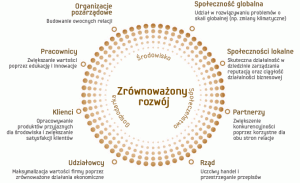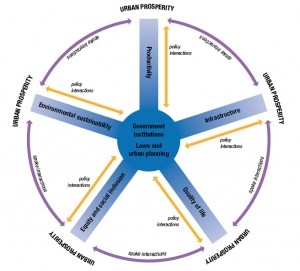Shared space is an urban design approach which seeks to minimize demarcations between vehicle traffic and pedestrians, often by removing features such as curbs, traffic signs, and regulations. In line with human nature.
The concept is strongly associated with a Dutch traffic engineer Hans Monderman, born in 1945. He thought that natural reactions of people make them find the city rhythm and get into it.
In an interview for The New York Times by Sarah Lyall he argued:
“Who has the right of way? I don’t care. People here have to find their own way, negotiate for themselves, use their own brains.” he said standing on a busy intersection stripped of all lights, signs, road markings and sidewalks. So different from what we are accustomed to in Poland. There was no division between road and sidewalk. But in spite of the apparently anarchical layout, the traffic, a steady stream of trucks, cars, buses, motorcycles, bicycles and pedestrians, moved along fluidly and easily. When Mr. Monderman deliberately failed to check for oncoming traffic before crossing the street, the drivers slowed for him. No one honked or shouted rude words out of the window. The site is used by some 20,000 drivers a Day.
The concept of shared space was first introduced by Hans Monderman in Drachten (the region of Friesland), the Netherlands. How does it work? To make communities safer and more appealing, Mr. Monderman argues, you should first remove the traditional paraphernalia of their roads – the traffic lights and speed signs; the signs exhorting drivers to stop, slow down and merge; the center lines separating lanes from one another; even the speed bumps, speed-limit signs, bicycle lanes and pedestrian crossings. In his view, it is only when the road is made more dangerous, when drivers stop looking at signs and start looking at other people, that driving becomes safer.
“All those signs are saying to cars, ‘This is your space, and we have organized your behavior so that as long as you behave this way, nothing can happen to you,’ ” Mr. Monderman said. “That is the wrong story.”
The Drachten intersection is an example of the concept of “shared space,” a street where cars and pedestrians are equal, and the design tells the driver what to do.
“It’s a moving away from regulated, legislated traffic toward space which, by the way it’s designed and configured, makes it clear what sort of behavior is anticipated,” said Ben Hamilton-Baillie, a British specialist in urban design.
Highways, where the car is naturally king, are part of the “traffic world” and another matter altogether. In Mr. Monderman’s view, shared-space schemes thrive only in conjunction with well-organized, well-regulated highway systems.
On a daylong automotive tour of Friesland, he pointed out places he had improved, including a town where he ripped out the sidewalks, signs and crossings and put in brick paving on the central shopping street. When an elderly woman crossed slowly in front of him, he commented on that: “This is social space, so when Grandma is coming, you stop, because that’s what normal, courteous human beings do.”
Mr. Monderman is considered one of the field’s great innovators, although until a few years ago he was virtually unknown outside Holland. Mr. Hamilton-Baillie, whose writings have helped bring Mr. Monderman’s work to wider attention, remembers with fondness his own first visit. “He said: ‘What do you expect to find here? Wallabies?’ ” Mr. Hamilton-Baillie recalled. ” ‘They’re treating you like you’re a complete idiot, and if people treat you like a complete idiot, you’ll act like one.’ “He was someone who had rethought a lot of issues from complete scratch.
Monderman was working as a civil engineer building highways in the 1970’s when the Dutch government, alarmed at a sharp increase in traffic accidents, set up a network of traffic-safety offices. Mr. Monderman was appointed Friesland’s traffic safety officer. Mr. Monderman began narrowing the roads and putting in design features like trees and flowers, red brick paving stones and even fountains to discourage people from speeding (following the principle now known as traffic calming).
He made his first nervous foray into shared space in a small village used as a daily thoroughfare for 6,000 speeding cars. When he took away the signs, lights and sidewalks, people drove more carefully. Within two weeks, speeds on the road had dropped by more than half. He said there has never been a fatal accident on any of HIS roads.
Several early studies bear out his contention that shared spaces are safer.
Hans Monderman died in January 2008. received an Honorary Doctor of Philosophy degree in traffic planning for outstanding achievements in the fields of traffic engineering, urban design, and project management. In 2005 he was nominated for the World Technology Award.
Variations on the shared-space theme are being tried in Spain, Denmark, Austria, Sweden and Britain, among other places. The European Union has appointed a committee of experts, including Mr. Monderman, for a Europe-wide study.
Monderman’s concept was implemented in a German town Bohmte (the cost of removing traffic signs was covered by the EU – € 1.2 m). Beforehand, the average was about 50 accidents a year. One month after the shared space system was introduced, there was not a single accident whatsoever.
Unfortunately, in Poland there are no solutions of this kind, though hope flickers on Vistula River. The city of Łódź is currently testing a scheme of prioritizing the pedestrians in traffic: in one of intersections there is a default green light on a zebra crossing. Roads and Transportation Management Office announced that if the solution works well, it will be copied on crossings near schools. But isn’t it against Monderman’s theory to put pedestrians before drivers? In shared space concept there are no equal and more equal. However, perhaps in a country like Poland implementation plan should start with a safety valve.






